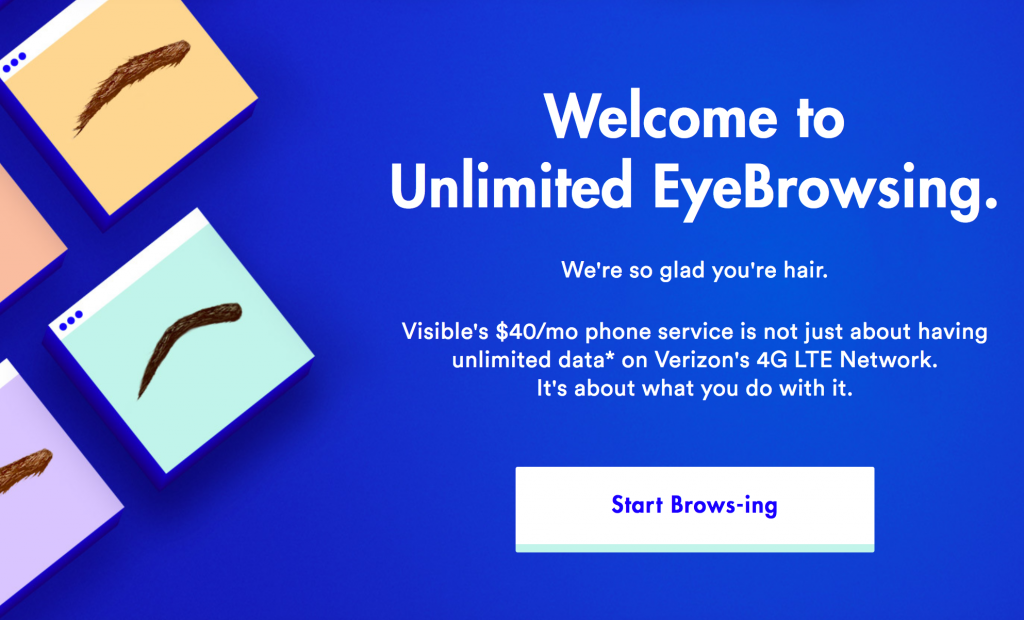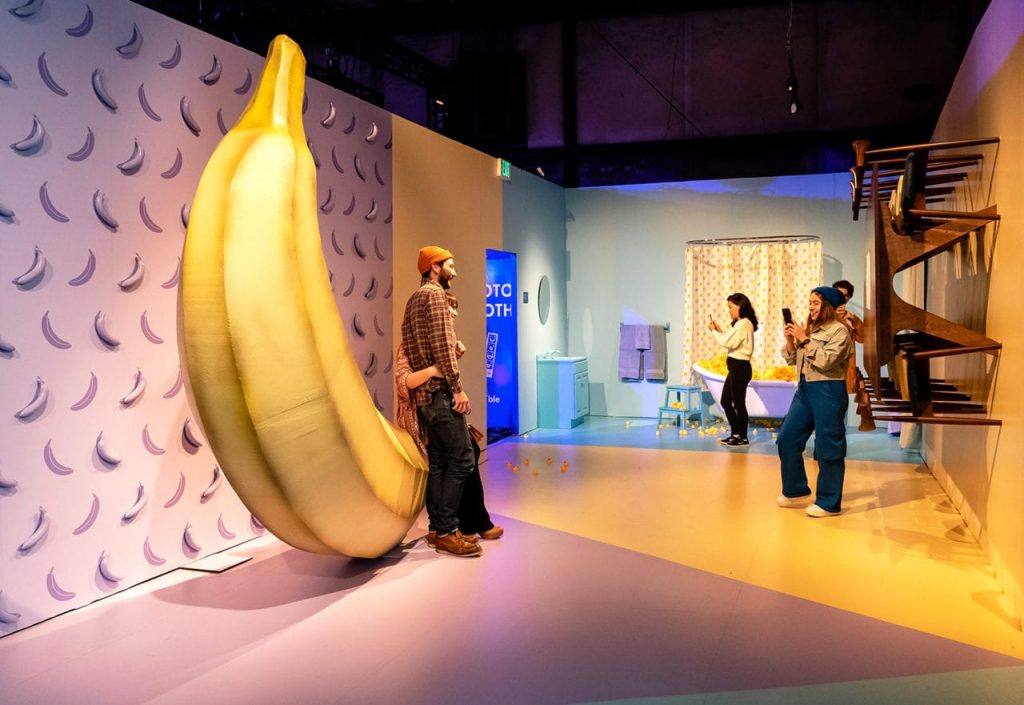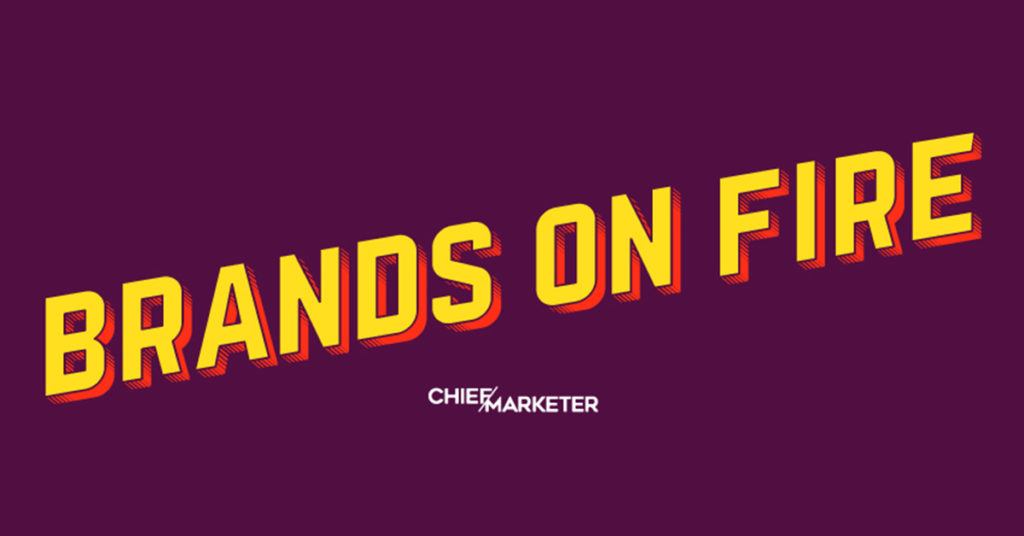Our monthly analysis of the world’s top brands and the marketing moves that are setting them apart.
—
Does anyone find shopping for wireless data plans fun? Probably not. Nonetheless, wireless service Visible was built from the ground up to be fun and approachable, said Kirstie Rivard, the brand’s Head of Experiential, during a keynote at the 2021 Experiential Marketing Summit last month. And that foundation extends far beyond experiential—to its quirky advertising, creative digital campaigns and social media marketing.
Puns and Games
Take the “12 Degrees of Kevin Bacon” TV spot that Visible launched in February. Actor Bacon himself explains that rather than settling for “six degrees of me,” he’s planning to enlist a dozen people to sign up for Visible, one each month. That’s because with Visible’s Party Play plan, for each month that someone you recommend enrolls, the cost of your monthly standard plan is reduced from $25 to $5.
Rather than hammering home the numbers, however, the ad shows Bacon floating in his pool, persuading his dentist and members of a “really hip acupuncture group” to sign up, getting two of his stunt doubles into the plan, and even lazing with (and selling the plan to) fellow actor Michael Gross, who already has just one degree of separation from Bacon thanks to both of them starring in the 1990 film “Tremors.” What’s more, Visible’s Instagram account reminded visitors that “Once you switch to Visible, you will officially be within two degrees” of Kevin Bacon.
An earlier spot for Party Play, shown on OTT and social media, featured an actress playing a gamer who enrolled into her “party” people she sees daily as well as those she knows only online. “People are finding each other on social media, and a big portion of people who are in parties together didn’t even know each other before joining the plan together,” Pearl Servat, Visible’s head of brand marketing, told MediaPost. “There are even 13,000 members on a Visible subreddit that exists for the sole reason of helping people join up for a party.”
Visible’s previous campaign, which debuted in November 2020, boasted that its unlimited data plan allowed for limitless browsing… or “eyebrowsing.” Dan Levy, riding a wave of awards and accolades for his TV series “Schitt’s Creek”—and owner of an impressive pair of eyebrows—appeared in five TV spots.
The brand also created a pun-filled website, UnlimitedEyebrowsing.com, that included games and even a “browse with your eyebrows” feature with which mobile users could literally raise their eyebrows to see a new page. Visible and its agency Madwell created more than 300 eyebrow-related assets in all. The campaign generated more than 518.7 million PR impressions; in addition, more than 183,000 unique visitors headed to UnlimitedEyebrowsing.com, and more than 2 percent of those visitors subsequently clicked on Visible.com.

Authenticity and Kindness
Visible didn’t air its first commercial until May 2020, almost two years after launch. In it, “approachable” trumped “fun,” though its pastel visuals added whimsy and differentiated the brand from its competitors. Because COVID-19 was keeping consumers at home—where they were watching more TV and reaching out more to friends and family via phone—Visible chief marketing officer Minjae Ormes felt this was the right time to expand the brand’s marketing efforts beyond digital and experiential. And because the pandemic was forcing many to cut their household budgets, she also felt the time was right to promote Visible’s value proposition.
“Thirty-three million people are unemployed in the U.S. right now, and it’s only going to last longer, so the product and business model we’ve built here—in a weird way— is right for helping people and fitting their needs today,” Ormes told Campaign US. “We want to introduce the product to people who don’t know about us. This isn’t about the moment or saying ‘We’re here for you because of everything going on.’”
The introductory commercial coincided with the “Visible Acts of Kindness” social campaign the company introduced in the early days of the pandemic. With a boost from influencers including Levy, “Top Chef” host Padma Lakshmi and pro hockey player P.K. Subban, Visible encouraged people to post examples of how individuals were helping others—in ways large and small—on their social channels with the hashtag #VisibleActsofKindness.
More than 13,000 people submitted posts, according to CEO Miguel Quiroga, and the company donated $250,000 in Amazon gift cards to 1,000 families in need. Visible reaped benefits as well: more than 5.5 million impressions, nearly 2 million “meaningful” engagements with potential customers, and a 40 percent boost in brand sentiment on its social media.
Efforts such as this showed there’s more to Visible than playfulness. “You can be fun and approachable as a brand,” Rivard said at the Experiential Marketing Summit, “but you can also be sincere and honest and authentic.”
Making It Real
Unlike other wireless services, Visible doesn’t have storefronts or any other physical presence. So events have been part of its marketing mix from year one. That’s when it intentionally slipped a typo into OOH ads, promising “free massages” rather than messages, then followed up with massage kiosk at Union Station in its hometown of Denver. Shortly after, Visible created Phonetopia, a 12,000-square-foot interactive exhibition designed to make mobile communications tangible.

Phonetopia included a tub filled with rubber ducks where visitors could perfect their selfie “duck face” and an obstacle course that led guests to literally “slide in” to a pit filled with foam D’s and M’s. The space also hosted a series of intimate concerts by Haim, Kacey Musgraves and other marquee names. To get on the 200-guest list, people had to register on the Phonetopia website.
“As a digital brand we do not exist in your physical life because the product we’re selling is a phone service that is invisible,” Ormes told Event Marketer. “And we do not have physical stores—our storefront is Visible.com and the app experience. So we wanted to make sure that we also show up in people’s lives in a way that looks physical and tactile.” What’s more, she said, people who came to Visible via experiential marketing were up to three times more likely to convert than those introduced to the brand via other channels.
Given that the pandemic made producing events challenging, you might think Visible would have paused its experiential marketing. Instead, in early September 2020 it produced Red Rocks Unpaused, three evenings of free concerts at Denver’s celebrated Red Rocks Amphitheatre. The venue was empty when the likes of Megan Thee Stallion and Sam Hunt performed, but the more than 8.6 million people who streamed the shows were able to send messages to the performers as well as to fellow viewers—and even have those messages displayed on the rock walls of the amphitheater. Other interactive features included voting on encore songs and cheering into devices to set off lights in the venue.
Not only did the number of viewers exceed Visible’s goal by 457 percent, but visits to its microsite beat expectations by 155 percent. The event garnered more than 2.5 billion earned media impressions, and more than 7 million people engaged with the organic social media posts. “Meaningful connections are just the most important thing for us,” Madwell account supervisor Charlie Smith told Fast Company, “whether it’s an experiential activation or a digital activation.”




